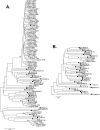Performance comparison of the versant HCV genotype 2.0 assay (LiPA) and the abbott realtime HCV genotype II assay for detecting hepatitis C virus genotype 6
- PMID: 25100817
- PMCID: PMC4187793
- DOI: 10.1128/JCM.00882-14
Performance comparison of the versant HCV genotype 2.0 assay (LiPA) and the abbott realtime HCV genotype II assay for detecting hepatitis C virus genotype 6
Abstract
The Versant HCV genotype 2.0 assay (line probe assay [LiPA] 2.0), based on reverse hybridization, and the Abbott Realtime HCV genotype II assay (Realtime II), based on genotype-specific real-time PCR, have been widely used to analyze hepatitis C virus (HCV) genotypes. However, their performances for detecting HCV genotype 6 infections have not been well studied. Here, we analyzed genotype 6 in 63 samples from the China HCV Genotyping Study that were originally identified as genotype 6 using the LiPA 2.0. The genotyping results were confirmed by nonstructural 5B (NS5B) or core sequence phylogenetic analysis. A total of 57 samples were confirmed to be genotype 6 (51 genotype 6a, 5 genotype 6n, and 1 genotype 6e). Four samples identified as a mixture of genotypes 6 and 4 by the LiPA 2.0 were confirmed to be genotype 3b. The remaining two samples classified as genotype 6 by the LiPA 2.0 were confirmed to be genotype 1b, which were intergenotypic recombinants and excluded from further comparison. In 57 genotype 6 samples detected using the Realtime II version 2.00 assay, 47 genotype 6a samples were identified as genotype 6, one 6e sample was misclassified as genotype 1, and four 6a and five 6n samples yielded indeterminate results. Nine nucleotide profiles in the 5' untranslated region affected the performances of both assays. Therefore, our analysis shows that both assays have limitations in identifying HCV genotype 6. The LiPA 2.0 cannot distinguish some 3b samples from genotype 6 samples. The Realtime II assay fails to identify some 6a and all non-6a subtypes, and it misclassifies genotype 6e as genotype 1.
Copyright © 2014, American Society for Microbiology. All Rights Reserved.
Figures



Similar articles
-
Comparison of Sanger sequencing for hepatitis C virus genotyping with a commercial line probe assay in a tertiary hospital.BMC Infect Dis. 2019 Aug 22;19(1):738. doi: 10.1186/s12879-019-4386-4. BMC Infect Dis. 2019. PMID: 31438880 Free PMC article.
-
Comparison of Abbott RealTime HCV Genotype II with Versant line probe assay 2.0 for hepatitis C virus genotyping.J Clin Microbiol. 2015 May;53(5):1754-7. doi: 10.1128/JCM.03548-14. Epub 2015 Mar 4. J Clin Microbiol. 2015. PMID: 25740780 Free PMC article.
-
Evaluation of the Abbott realtime HCV genotype II RUO (GT II) assay with reference to 5'UTR, core and NS5B sequencing.J Clin Virol. 2014 May;60(1):22-6. doi: 10.1016/j.jcv.2014.02.006. Epub 2014 Feb 25. J Clin Virol. 2014. PMID: 24656214
-
Performance of Three Common Hepatitis C Virus (HCV) Genotyping Assays for Identification of HCV Genotype 2/1 Chimeras.J Clin Microbiol. 2019 Jun 25;57(7):e00060-19. doi: 10.1128/JCM.00060-19. Print 2019 Jul. J Clin Microbiol. 2019. PMID: 31043467 Free PMC article.
-
Profile of the VERSANT HCV genotype 2.0 assay.Expert Rev Mol Diagn. 2018 Dec;18(12):995-1004. doi: 10.1080/14737159.2018.1541740. Epub 2018 Nov 2. Expert Rev Mol Diagn. 2018. PMID: 30372355 Review.
Cited by
-
Sequencing Analysis of NS3/4A, NS5A, and NS5B Genes from Patients Infected with Hepatitis C Virus Genotypes 5 and 6.J Clin Microbiol. 2016 Jul;54(7):1835-1841. doi: 10.1128/JCM.00238-16. Epub 2016 May 4. J Clin Microbiol. 2016. PMID: 27147726 Free PMC article. Clinical Trial.
-
Comparison of Sanger sequencing for hepatitis C virus genotyping with a commercial line probe assay in a tertiary hospital.BMC Infect Dis. 2019 Aug 22;19(1):738. doi: 10.1186/s12879-019-4386-4. BMC Infect Dis. 2019. PMID: 31438880 Free PMC article.
-
A novel point-of-care oral anti-HCV assay: Is it reliable for screening hepatitis C virus infection in the era of direct-acting antivirals?PLoS One. 2019 Feb 12;14(2):e0211795. doi: 10.1371/journal.pone.0211795. eCollection 2019. PLoS One. 2019. PMID: 30753207 Free PMC article. Clinical Trial.
-
Development of a Method for Screening and Genotyping of HCV 1a, 1b, 2, 3, 4, and 6 Genotypes.ACS Omega. 2020 May 8;5(19):10794-10799. doi: 10.1021/acsomega.0c00386. eCollection 2020 May 19. ACS Omega. 2020. PMID: 32455199 Free PMC article.
-
Clinical Laboratory Testing in the Era of Directly Acting Antiviral Therapies for Hepatitis C.Clin Microbiol Rev. 2017 Jan;30(1):23-42. doi: 10.1128/CMR.00037-16. Epub 2016 Oct 19. Clin Microbiol Rev. 2017. PMID: 27795306 Free PMC article. Review.
References
Publication types
MeSH terms
Grants and funding
LinkOut - more resources
Full Text Sources
Other Literature Sources
Medical

